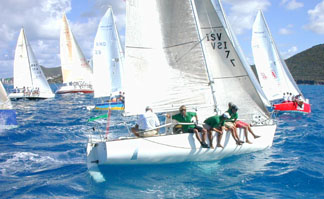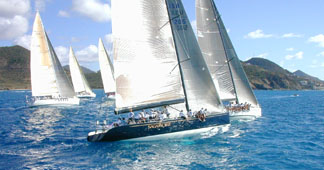
|
|
|
March 14 - Panama Canal This is how John Pearlman looked on the bow of his Sausalito-based Islander 37 Nepenthe on March 2, shortly before she was dismasted and badly damaged in Panama's Lake Gatun Locks. The second picture is of him with the wreckage that missed him as he escaped the Antares Royale. Here are his comments: "Strange how one's path can abruptly alter course. Of all the dangerous stretches I faced bringing Nepenthe the 3,000 miles back to San Francisco, who would have dreamed the 'path between the seas' would have been the riskiest leg?! When looking at pictures of the aftermath, with all the masts and debris laying strewn across the decks of the two sailboats, it's absolutely amazing no one was severely injured or killed. Here's a recap. "At 0830 on March 2, my Nepenthe and the 45' Swiss flagged ketch Antares Royale were 'nested' - meaning tied side by side. We motored into the first southbound chamber and Antares was then tied to a 100-ft tug that was tied to the side wall. The stern of a 600+ foot freighter was about 75 feet ahead. The water began to rise, and all was well until we were about 10 feet from the top. At that point, I looked back - having just taken a picture of my smiling friend Bill - and saw the stern of the tug drifting away from the wall. "I think we're in trouble," I muttered to Bill. I ran to Nepenthe's engine controls, put it in reverse and applied full throttle, but there was no effect. As it became evident that impact with the stern of the freighter was imminent, the advisors began shouting for us to hop on the tug. I stayed in the cockpit until the mast - with a bone-chilling cracking and crunching - broke as a result of hitting the freighter's overhang, and when Nepenthe's hull and deck began to slide under the freighter's deeply beveled stern. At that point, I actually had to climb 'up' to the starboard side of the boat to leap onto Antares. "Thoughts of being crushed between the ship and Nepenthe wrung epinephrine from my adrenals, and catapulted me past Antares and into the tug. I had no awareness of falling masts during my short, heart-thudding journey across the boats, yet upon reaching the relative safety of the tug stern, I looked back and couldn't see an area of deck that wasn't riddled with debris. After all crew members from both boats were on the tug, the lower half of Antares' main mast came crashing down - not more than a foot from our advisor's head and just a few inches from my crew's arm. As you might imagine, we were all in shock as the war-like scene lay before us. "One of the most pleasant surprises has been the gentle and caring way the Canal officials have comported themselves. Even the technicians who disconnected the rigging from the chain plates to allow the removal of the mast did it with such care, inserting each cotter pin into its clevis pin after placing it back into its turnbuckle. |
Photos Courtesy Nepenthe "Three days after the incident, there was a formal hearing to determine what had gone wrong. To my relief and that of the owners of Antares Royale, Capt. Rodriguez, the head of the Panama Canal Authority which is heading this investigation, turned out to be a most empathetic, kind, soft spoken, good humored man. He actually apologized to us for this obvious blunder on the part of the tug crew. He said he could make a ruling from what he'd heard, but had to wait to follow protocol. "What went wrong can be divided into two parts. 1) The boatswain handling the tug's stern line, through inattention, allowed the required five wraps on the winch capstan to come undone, Before he was able to refasten it, the tug had swung so far away from the wall that the distance exceeded the length of the line. 2) The tug captain, if he had been behind the controls properly operating his mighty 3,000 horsepower twin engine egg-beater ship, considered to be perhaps the most maneuverable water craft on earth, should have had no problem pulling the stern back to the wall. Why didn't he? He maintains that if he'd applied enough power to pull the tug back to the wall, he would have torn the lines from the sailboats. Huh? So the alternative was to do nothing and let them crash into the freighter? He then stated that the sailboats' keels impeded his tug's propulsion, and he was therefore unable to maneuver back to the wall. Upon some pointed questioning by Captain Rodriguez - who is himself a qualified tug captain - this explanation didn't make much sense. The tug's turbines are 17 feet deep with 10-ft blades from the bottom up, and are located in front of the steering house. The sailboats were tied so their bows were aft of the steering house, and they drew 5.5 feet and 7 feet. It seemed obvious to all present at the hearing that one of three scenarios occurred regarding the conduct of the tug captain: A) He was not in the wheel house. B) He was asleep in the wheel house. C) He panicked and failed to operate the tug properly. "I'm now at Pedro Miguel, a marina in the middle of the Canal, living among the ruins of my boat. It's quite depressing. The next step is to get a survey and submit it to the Canal Authority, then await their ruling on compensation. Ah, to be among the islands again." |
March 14 - U.K.
From the '70s through the '90s, the Admiral's Cup in England was
considered to be the offshore racing championship of the world.
In its golden years, three-boat teams representing countries from
all over the world would attend. In fact, numerous boats from
the Bay Area competed on behalf of the United States, including
Dave Allen's Imp (twice), Randy Short's Sidewinder
(twice), Irv Loube's Bravura, and Munro Wingate's Scarlett
O'Hara.
Two days ago, however, the U.S. dropped the bomb by saying for only the second time in the history of the Admiral's Cup we will not be sending a team. The only firm member of the team was Philippe Kahn of Santa Cruz with the Farr 40 Pegasus. The announcement has created an uproar, and suggestions that the Admiral's Cup might not even be held. For while Britain, France and Italy have all confirmed they will enter three-boat teams, the defending champs from Holland will not be sending a team, nor will New Zealand, and Australia is shaky. In the old days, there would be a dozen teams for this prestigious competition, but now they'll be lucky to have five - or even have an event.
Many reasons are given for the decline of the Admiral's Cup, but we suspect the biggest is the general broadening of sailing competitions - the America's Cup, The Race, the Vendée Globe, and on and on. The Admiral's Cup is simply not the pinnacle of the sailing world that it once was.
Heineken RegattaMarch 14 - St. Maarten How blue was the water at St. Maarten for the early March Heineken Regatta? As you can see from these photos by Max Ebb of Latitude 38, if the water was any bluer, it would almost be as pretty as the water in San Francisco Bay. Right. We'll have more Heineken photos in 'Lectronic, and we'll have the full story in the April Latitude. |
 |
|
|
 |
March 14 - The Pacific Ocean and Cyberspace
Who is out making passages in the Pacific and what kind of weather are they having? Check out YOTREPS - 'yacht reports' - at http://www.bitwrangler.com/yotreps/
March 14 - Pacific Ocean
To see what the winds are like on the Bay and just outside the Gate right now, check out http://sfports.wr.usgs.gov/wind/.
Looking for current as well as recent wind and sea readings from 17 buoys and stations between Pt. Arena and the Mexican border? Here's the place - which has further links to weather buoys and stations all over the U.S.: www.ndbc.noaa.gov/stuff/southwest/swstmap.shtml.
Seas are normal in the Pacific. But you
might check out the Pacific Ocean sea states at: http://www.mpc.ncep.noaa.gov/RSSA/PacRegSSA.html.
For another view, see http://www.oceanweather.com/data/global.html.
Top / Index of
Stories / Subscriptions
/ Classifieds
/ Home©2001
Latitude 38 Publishing Co., Inc.